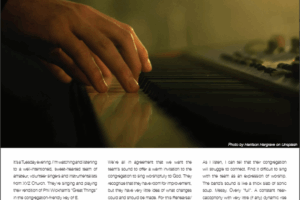Take this link to read the full article about Grant's More Than Music Workshops, as…

THE BOY, THE BED & THE BAND
By Grant Norsworthy
I’ve learned a lot from seeing my sons bouncing on my wife’s and my bed. It seems that age three is the optimal age for this activity. Old enough to bounce without falling off the edge. Small enough not to damage the bed! First it was our oldest Max, then the middle son Marcus and right now it’s our youngest, Casper.
This picture – a 3-year-old boy bouncing on a queen size bed – informed my musical choices as the bassist with bands like PC3 (Paul Colman Trio) and Sonicflood.
But these days I’m more often in the role of Musical Director, instructor and consultant for multiple bands – most commonly in Church music situations. The applications for the bouncing-toddler illustration have grown exponentially into a way of thinking about music in general; giving a clear goal to work towards when crafting a band’s sound to effectively engage a church congregation to worship God through songs.
Picture this: My 3-year-old son Casper leaping exuberantly through the air, arms flailing, face beaming, propelled by his little legs springing off mommy and daddy’s bed. It’s an engaging picture. It draws people in.
Think of the bouncing boy as the vocal melody and the lyric of the song. That’s the most important element of this picture and of our song. That’s what we are asking people to connect with, resonate with, sing along to.
The bed that Casper is bouncing on has two halves – mommy’s side and daddy’s side. These two halves of one whole in our band’s sound are the bass guitar and the drums – more specifically the kick drum. The parts being played by these two must be connected, solid, foundational and support the vocal melody and lyrics. They allow the boy to bounce!
The lower frequencies of these instruments, when mixed correctly, have the power to move people, shift air, create a vibe and groove for the music while never invading the frequency range – the sonic space – of the song’s melody. Given a suitable sound system, lower frequencies can be put to dynamic use while never making the band sound too loud or hurting any ears.
There are other elements to the picture – comforter, pillows, wall hangings and so on – that add interest and color to the overall picture. But the little boy will bounce without them. These are our guitars, keyboards, harmony vocals and any other instrumentation we might add. Any one of them is not essential to the success or failure of the song. They must not clutter the sonic space of the melody and the lyrics. Unless there is an instrumental passage to a song, they must never compete for the attention of the listener.
There is a myriad of practical applications from this illustration to musical direction. With any band I am leading, in this order of priority, I work with purpose to:
- consolidate the song’s melody and unify the vocal style of the singers,
- make sure all vocalists are singing the same lyrics (and that they match the screens!),
- establish solid time-keeping and melody-supporting parts for drums and bass guitar,
- establish other instrumental parts that support, but never clutter the melody,
- make sure any harmony vocals are used sparingly and mixed lower than the melody, and
- ensure an overall mix that has clearly audible melody supported by robust low end.
This way of thinking about sound and music can help the whole team. Instrumentalists, singers and audio technicians alike can agree on a defined objective for our sound. This, in turn, can help each individual make better musical choices that facilitate the achievement of the agreed goal.
This article was first published by Worship Tech Director of the WFX Network on May 17, 2018.


